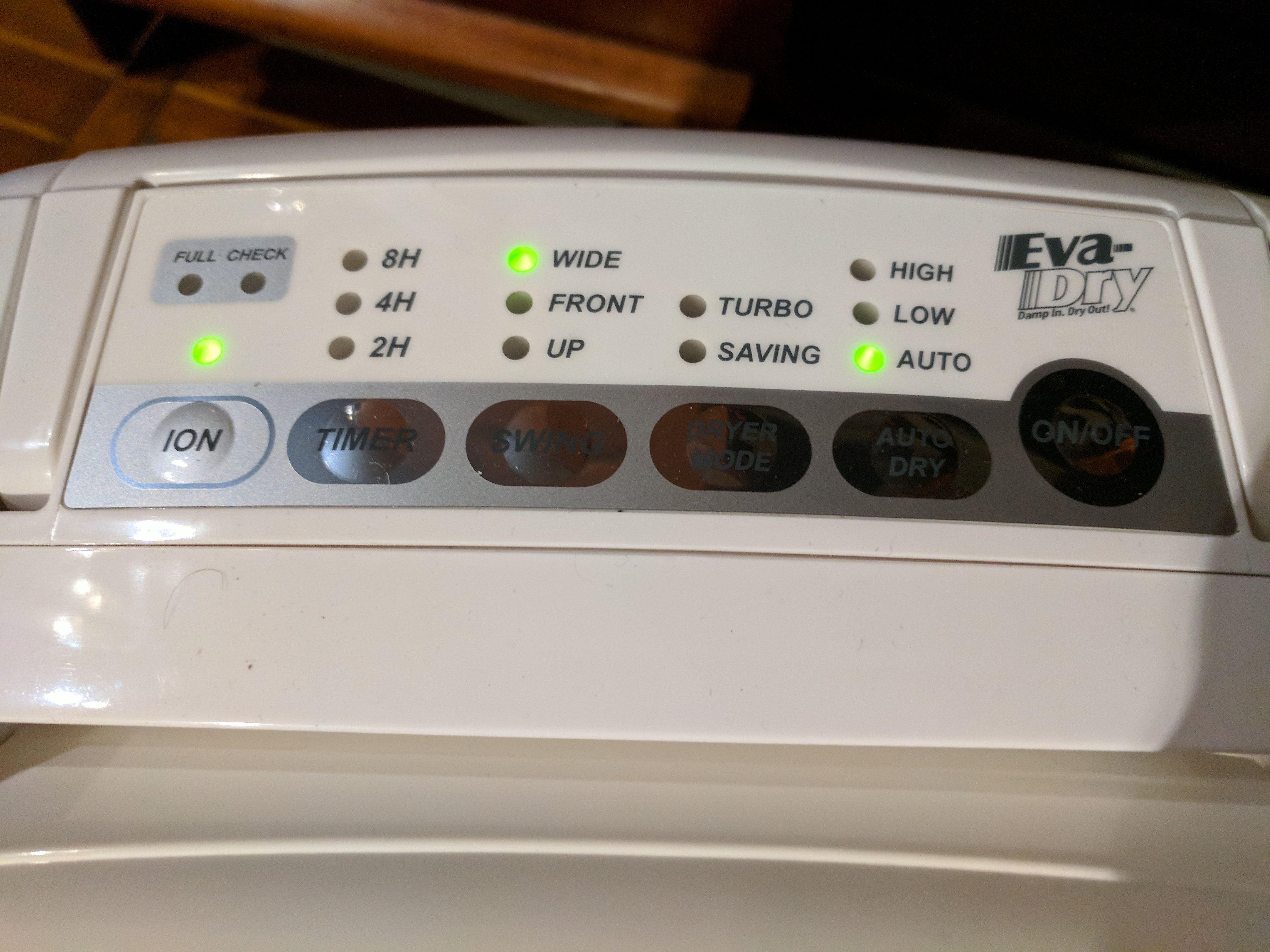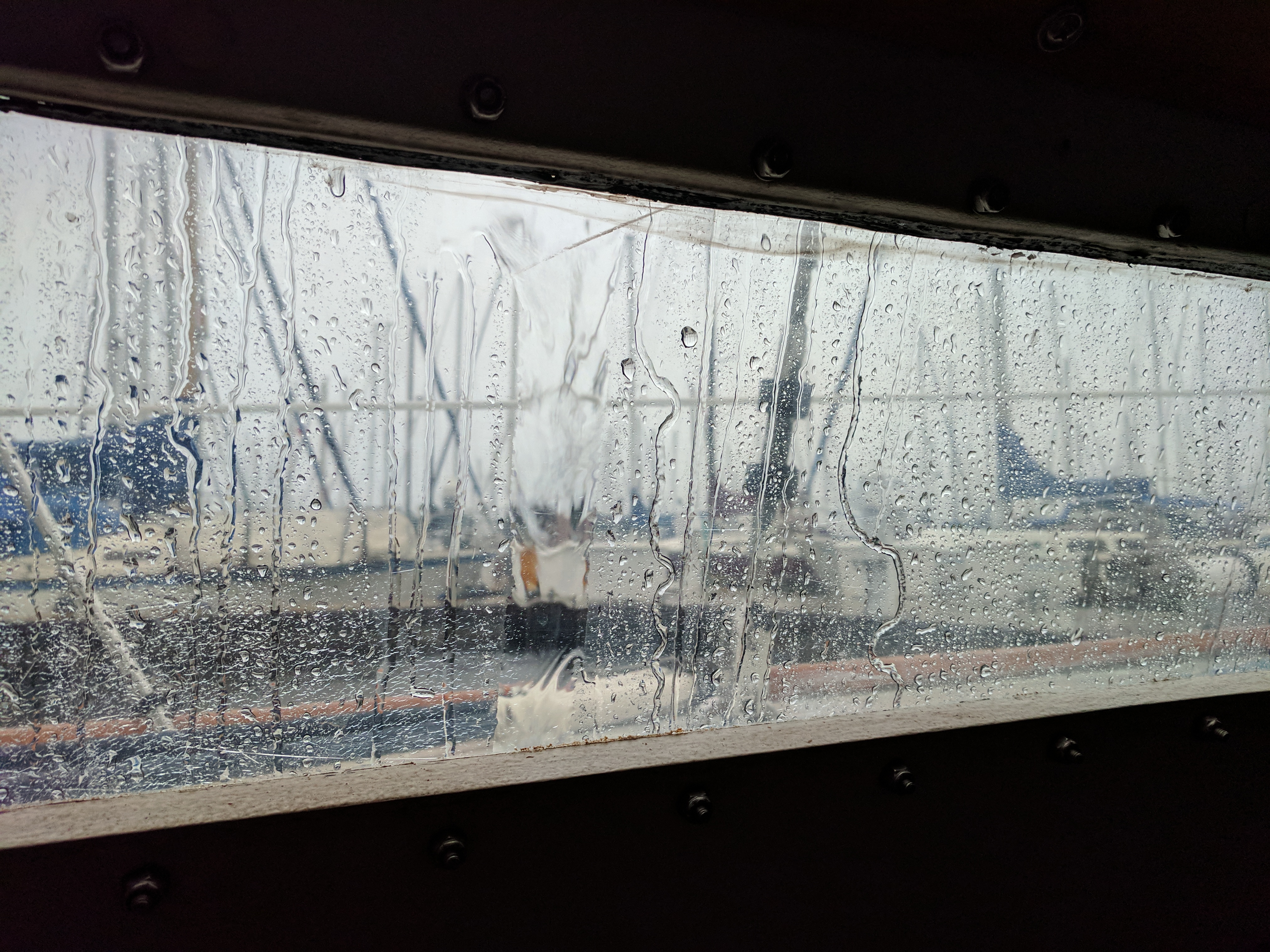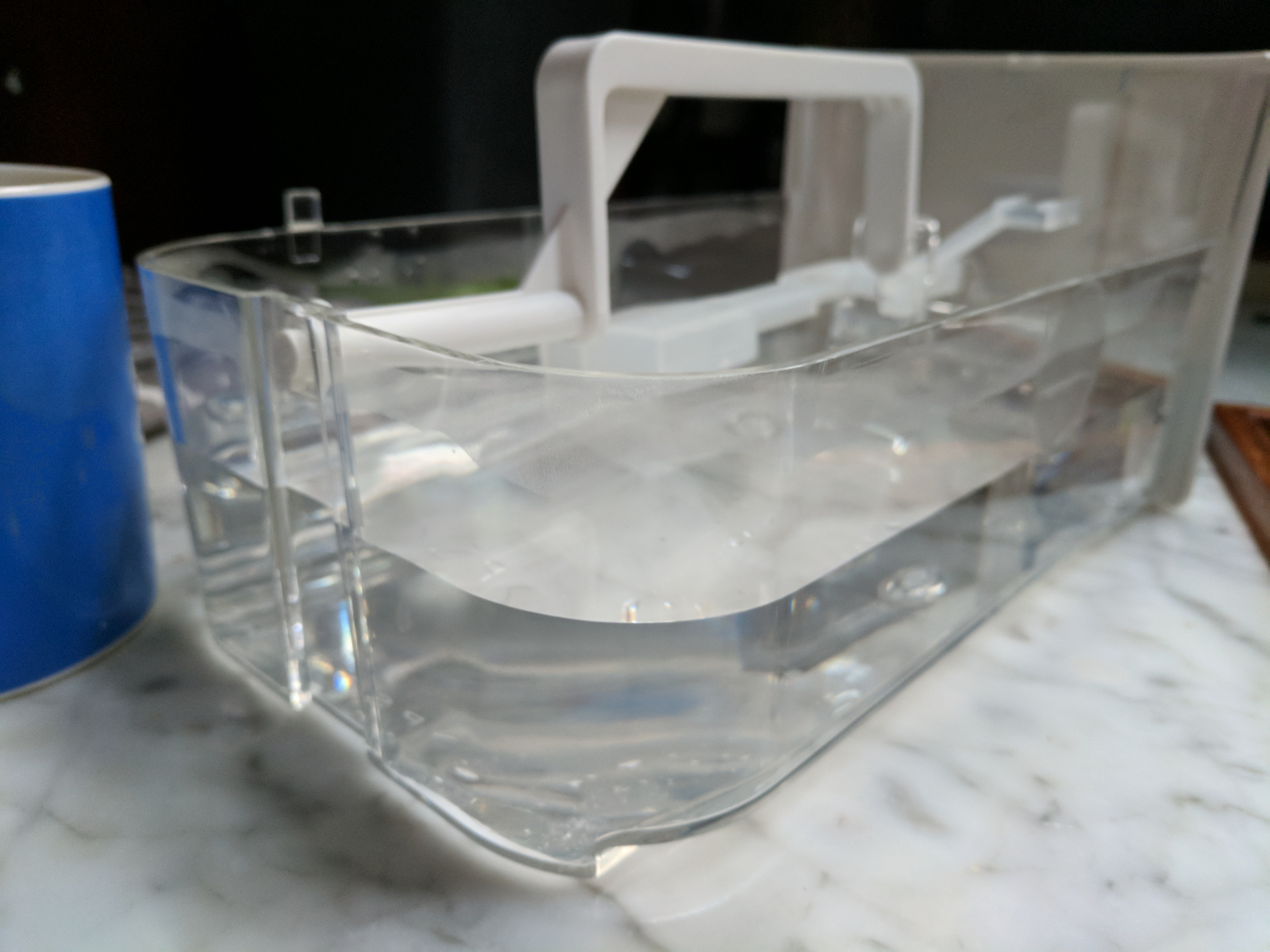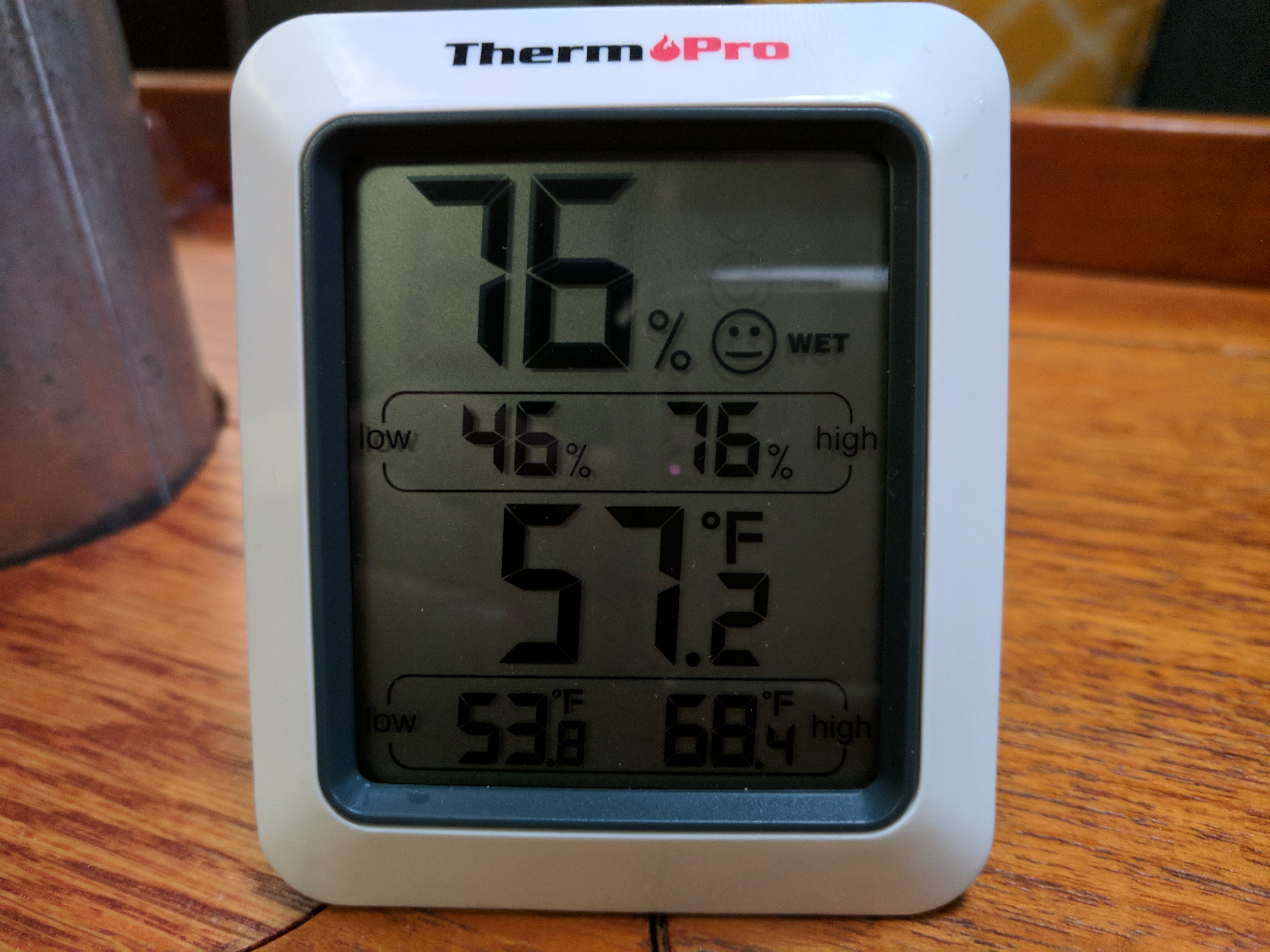Removing moisture from the boat is one of the first challenges for a liveaboard boat in the PNW. Every day, breathing, cooking, and rain drenched clothing add moisture vapor to the air, and that’s on top of a base level of high humidity the outside air is at during our rainy weeks. And let’s hope your boat doesn’t have any leaks, because that’ll just add more moisture to the boat as we get week after week of continuous rain.
We’re now 5 months into living aboard, and it’s going great! The moisture really started turning on about 3 weeks ago, when the night time temperatures became quite chilly. When the outside temp drops to 40 F but your cabin temp is 62 F, that warmer moist air hits a cold surface (hull walls, deck underside, metal deck fills and hatch frames) and quickly condensates.
We really want to prevent mold from forming (when we bought our boat we had a lot of mold to clean off the interior hull and hidden storage spaces: Tackling the Mold Monster (May 2015)) – and keeping the humidity reasonable is the key.

Controls on the EDV-4000

A PNW winter looks like this – day after day of rain
A Good Dehumidifier
The #1 tool for a liveaboard is a good hard-working dehumidifier. We had heard recommendations for the Eva-Dry EDV-4000 (no longer available, but the Ivation 19 [Amazon link] is quite similar) from 48 North and other cruisers, so that’s what we tried. And it’s working great! It pulls volumes more water out of the air than our small Eva-Dry EDV-1100 did.

Big Bertha (EDV-4000) and Little Bertha (EDV-1100)
The EDV-4000 is a bit pricey – around $250 on Amazon (or the Ivation 19 is $200). At that price you could buy five EDV-1100’s and scatter them to every area of your boat. But running 5 little guys would be a pain, and I actually think the EDV-4000 pulls more water out of the air than five EDV-1100s combined. It’s simply much more effective, and the small dehumidifiers are more like toys in comparison.
The EDV-4000 has pulled 2 liters of water from the boat in only one day, whereas the EDV-1100 takes about a week to pull 0.5 liters (0.07L/day). That’s a 28x difference. It’s rated to pull up to 7 L a day, but I’m guessing our boat would need to be really wet for it to do that.

Humidity / Temperature Monitor
I discovered you can get small battery-powered humidity / temperature monitors for as little as $10! (ThermoPro TP50) Along the lines of The Joy of Easy Projects, buying this monitor was a really easy project and provides a lot more than $10 in value to us. The engineer in me can now know definitively when moisture levels are too high, and it also helps us settle arguments about whether it’s too cold in the boat.

Other Moisture Tips
I started with the dehumidifier because I think that’s the most important humidity management tool. But there are other things to do as well:
- Stop leaks into your boat. Obviously, adding more water to the interior when it rains isn’t something you want.
Fortunately we’ve conquered most of these by now. Before the rains started, I rebedded our inner forestay chainplate, which had started leaking again even though I had rebedded it just 2 years ago! (with BoatLife caulk). This time I went with butyl – a little tricky to pack in around the chainplate, but I think it will hold up longer.
Now we just have two small toerail leaks remaining – which we’re going to try Captain Tolley’s Creeping Crack Cure on. And a window (fixed acrylic port) leak, which will be a big project since we need to replace the acrylic. - Ventilation. Keeping the air moving helps prevent mold formation and vent out moist air.
The storage area under our v-berth previously had *no* air ventilation, so another project I’ve been working on was to cut out an access window and install a vented teak door in that spot. - Leave wet clothes outside (if you have a covered cockpit) to drip dry.
- Reduce or avoid cooking foods that involve boiling water – pasta, rice, sauce reductions, etc.
Note that previously we have used desiccants (Damprid) – which is simply calcium chloride that draws moisture out of the air, particularly in unventilated spaces. I now think this is only useful on closed up boats that aren’t being used (ie, not liveaboards). When living aboard, you’re putting at least a liter or two of water vapor into the air every day, and a good dehumidifier is the only thing that is going to significantly reduce the humidity level.
We haven’t figured out yet our plan for dehumidifying while cruising, when we’re in anchorages 90% of the time. We don’t have an inverter powerful enough to run the 3 – 6 amp EDV-4000, but might be able to get one that will work with our 12V cigarette plug socket.

Nice setup! My machine looks very similar but is a different brand https://flic.kr/p/ZiTbdf
the averages for the last 2 weeks at my boat https://flic.kr/p/ZDQXuq
I’m not sure what the optimal relative humidity is but I may be able to dial back the dryness.
How to get the right humidity while at anchor is a problem I’d like to figure out too!
Patrick, have you considered insulating the hull as part of the war on condensation? I ask coming from a place of ignorance, as I haven’t lived aboard yet, but I’ve read about a few other PNW liveaboards going that route.
That’s a good question. We know people who have added sheet insulation to their hull walls in places. Our hull is already insulated pretty well though because it’s balsa cored. So wood coring acts as an insulator. In some areas the deck isn’t cored (at the edges approaching the deck-to-hull joint) and those areas sometimes show beads of condensation in the morning.
We could insulate more but that wouldn’t reduce the humidity level in the cabin – the moisture in the air needs to be removed somehow, and the dehumidifier plus ventilation do that. We’re going to try insulating film for our windows (http://amzn.to/2y0yEif ) to maybe improve heat retention.
I have the same model of dehumidifier – probably the best thing I’ve bought for getting through the winters.
under the V berth, try installing “Hypervent” helps a lot and provides an air space under your mattress.
Hypervent is great, we do have it under our v-berth mattress. The moisture we get in the storage under the v-berth though I believe is related to our water tank being in there, perhaps also the anchor locker at the fwd end, and the lack of ventilation (solved now).
Same dehumidifier aboard here in Anacortes….and under berths…Froli system instead of Hypervent. Best ventilation ever under a berth…AND the bed is comfortable to sleep on.
Patrick,
The small EDV 1100 does have a man available cigarette lighter adapter, to allow it to run while you’re on the hook.
The bad news is that it’s an ampere hog.